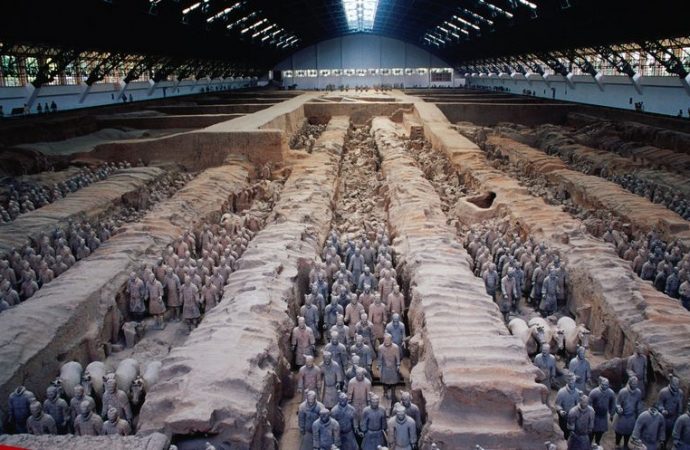Two Thousand Years Old Clay Soldiers and How They Were Made
Life-size means that the statues of the infantry soldiers range between 1.7 m (5 ft 8 in) and 1.9 m (6 ft 2 in); the commanders are all 2 m (6.5 ft) tall. The lower half of the kiln-fired ceramic bodies were made of solid terracotta clay, the upper half was hollow. The pieces were created in molds and then glued together with clay paste. They were fired in one piece; and neutron activation analysis indicates that the sculptures were made from multiple kilns scattered around the country side, although no kilns have been found to date.
Building–and Painting–a Terracotta Soldier
/about/three-coloured-terracotta-warrior-xian-china-82067493-575d60f83df78c98dc24f9b9.jpg)
After firing, the sculptures were coated with two thin layers of the poisonous east Asian lacquer (qi in Chinese, urushi in Japanese). On top of the glossy, dark brown surface of the urushi, the sculptures were painted with bright colors laid down thickly. Thick paint was used to imitate bird feathers or ornaments on a silk border; paint colors chosen involve blends with Chinese purple, cinnabar and azurite. The binding medium was egg white tempera. The paint, plainly visible to the excavators when the soldiers were first exposed, has mostly flaked and eroded away.
The images of what scholars suppose the paint looked like originally are eye-popping, but very rare on the internet, and I couldn’t get my hands on one for this feature. Be sure to peek at at the example shown in a 2012 article in China Daily.
Bronze Weaponry of Qin’s Terracotta Army
/about/close-up-of-tip-bronze-arrow-520264678-575c10c15f9b58f22eb039b2.jpg)
The soldiers were armed with numerous, fully-functional bronze weapons. At least 40,000 arrowheads and several hundred other bronze weapons have been found to date, likely hafted in wood or bamboo shafts. The metal parts which survive include crossbow triggers, sword blades, lance tips, spearheads, hooks, honor weapons (called Su), dagger-axe blades and halberds. The halberds and lances were inscribed with the regnal date of construction–the halberds made between 244-240 BC and the lances between 232-228 BC. Other metal objects often had the names of workers, their supervisors and workshops. Grinding and polishing marks on the bronze weapons indicate that the weapons were ground using a small hard stone rotary wheel or brush.
The arrowheads are extremely standardized in shape. They were composed of a triangular pyramid-shaped point; a tang fitted the point into a bamboo or wooden shaft and a feather was attached at the distal end. The arrows were found bundled in groups of 100 units, probably representing a quiver’s worth. The points are visually identical, although tangs are one of two lengths. Neutron activation analysis of the metal content shows they ere made in batches by different cells of workers functioning in parallel; the process most likely reflects the way they did it for those used by flesh-and-blood armies.
The Lost Art of Shi Huangdi’s Pottery Kilns
/about/terracotta-army-horse-mausoleum-of-emperor-qin-shi-huang-unesco-world-heritage-list-1987-china-3rd-century-bc-detail-549581221-575c14495f9b58f22eb5a46f.jpg)
Building 8,000 life-sized pottery gentlemen, not to mention the animals and other terracotta sculptures found in the Qin’s tomb, must have been a formidable task. And yet–no kilns have been found associated with the emperor’s tomb. Several pieces of information suggest that the manufacturing took place by workmen in many locations: the names of workshops on some of the bronze objects, the different metal content of the arrow groups, different types of soils used for the pottery… and pollen as well.
Pollen granules were found in low-fired sherds from Pit 2. Pollen from the horse statues matched that of the near vicinity of the site–Pinus (Pine), Mallotus (spurge), and Moraceae (mulberry). That of the warriors, however were mostly herbaceous–Brassicaceae (mustard or cabbage), Artemisia (wormwood or sagebrush), and Chenopodiacaea (goosefoot). Researchers Hu et al postulate that horses with their thin legs were more prone to breakage while being hauled long distances, and so were built in kilns closer to the tomb.
Are the Terracotta Soldiers Portraits of Individuals?
/about/daily-life-in-xi-an-450488390-575d61c25f9b58f22ed3e9b7.jpg)
The soldiers have an amazing amount of variations in headgear, hairdos, costumes, armor, belts and belt hooks, and boots and shoes; and especially facial hair and expression. Art historian Ladislav Kesner (1995), quoting Chinese scholars, argues that despite the specific traits and seemingly endless diversity of the faces, the figures are better viewed not as individuals but as “types”–the goal being to produce the appearance of individuality. The physicality of the statues is frozen, and the postures and gestures are representations of the clay soldier’s rank and role.
Kesner points out that the art challenges those in the Western world who conceptually see individuality and type as separate things: the Qin soldiers are both–individually particularized types. He translates the Chinese scholar Wu Hung, who said that the goal of reproducing portrait sculpture would be alien to Bronze Age ritual art, which “aimed to visualize an intermediate stage between the human world and beyond it”. The Qin sculptures are a break with the Bronze Age styles–but echoes are still seen in the cool distant expressions on the soldiers’ faces.
Source: Thought Co.

































Leave a Comment
You must be logged in to post a comment.